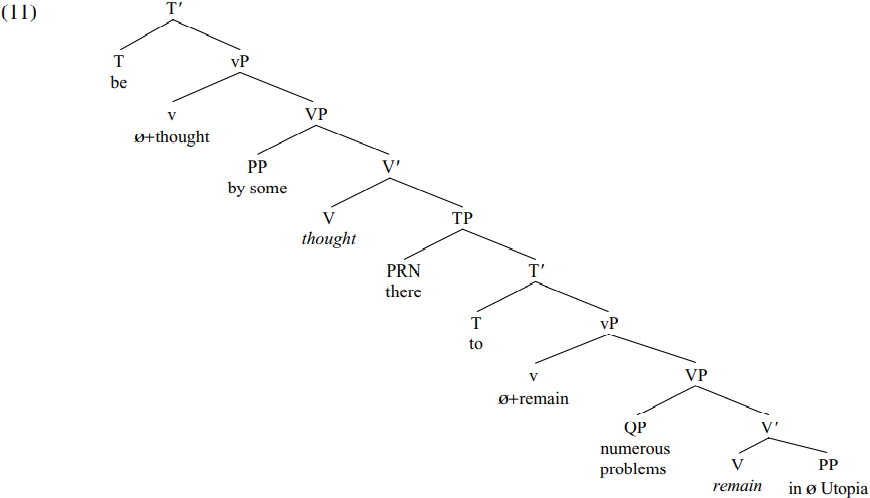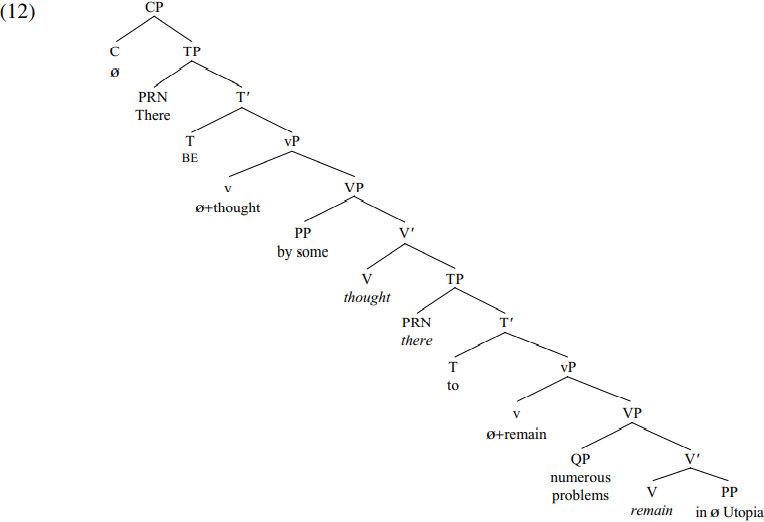
Intransitive and defective clauses
 المؤلف:
Andrew Radford
المؤلف:
Andrew Radford
 المصدر:
Minimalist Syntax
المصدر:
Minimalist Syntax
 الجزء والصفحة:
385-10
الجزء والصفحة:
385-10
 2023-02-15
2023-02-15
 1909
1909
Intransitive and defective clauses
Our illustrative account of phases involved a structure containing a transitive vP phase and a CP phase. However, since neither intransitive clauses (i.e. those containing a vP with no external argument) nor defective clauses (i.e. clauses which are TPs lacking a CP projection) are phases, things work differently in such structures – as we can illustrate in relation to the derivation of:

The unaccusative verb remain merges with its LOCATIVE complement in ø Utopia (Utopia being a DP headed by a null determiner) to form the V-bar remain in ø Utopia, and this V-bar is in turn merged with its THEME argument (the quantifier phrase numerous problems) to form the VP numerous problems remain in ø Utopia. This VP in turn is merged with a null light verb which, being affixal, triggers movement of the verb remain from its italicized position in V to adjoin to the light verb, so deriving:

Although a transitive vP is a phase (and requires its domain to be spelled out), the vP in (9) is intransitive because it has no external argument (i.e. vP has no specifier). Hence, its VP complement does not undergo transfer at this point, and the syntactic derivation proceeds by merging the resulting vP with infinitival to. If (as Chomsky 2001, fn. 56 argues) infinitival to has an [EPP] feature and a person feature in defective clauses, it follows that to must project a specifier with person properties. In keeping with Chomsky’s own assumptions about expletive there being directly generated in spec-TP and preference of Merge over Move, let’s suppose that this requirement is satisfied by merging expletive there in spec-TP, so deriving:

The TP in (10) is then merged as the complement of the passive participle thought, forming a V-bar constituent which is in turn merged with the AGENT by-phrase by some to form a VP. Given our assumption that all verb phrases have a complex shell structure, the resulting VP will in turn be merged as the complement of a light verb (arguably one which is participial in nature, so accounting for why the verb is eventually spelled out in the passive-participle form thought, and why Chomsky 1999 uses the label PRT to denote the relevant participial head): since light verbs are affixal in nature, this means that the verb thought will raise to adjoin to the light verb. Merging the resulting vP with the passive auxiliary BE will derive the T-bar constituent shown below:

At this point, BE is an active probe by virtue of its uninterpretable (and unvalued)  -features, and so it searches for an accessible active goal to value its person/number features. There are two such goals within the structure in (11), namely the third-person-expletive pronoun there (active by virtue of its uninterpretable person feature) and the third-person-plural QP numerous problems (active by virtue of its uninterpretable and unvalued case feature). Both there and numerous problems are accessible goals for BE since neither is contained within a structure which has undergone transfer. Chomsky (2001) suggests that a probe P locates every active matching goal G within its search space (i.e. within that part of the syntactic structure which is accessible to the probe by virtue of not yet having undergone transfer), and that where there is more than one such goal, the probe simultaneously agrees with all the relevant goals at the same time: cf. his (2001, p.13) remark that ‘P can find any matching goal in the phase PH that it heads, simultaneously deleting uninterpretable features.’ (We can assume that the pronoun some is not active at this point, because it falls within the domain of a closer probe by which will already have valued its case feature as accusative.) What this means is that since BE has uninterpretable person and number features, it will locate every active goal within its search space which has a person and/or number feature. Since there has a third-person feature which is uninterpretable (making it active), there is one such goal; likewise, numerous problems is another active goal, since it has third-person and plural-number features and is active by virtue of its uninterpretable case feature. Accordingly, BE simultaneously agrees in person with there and numerous problems, and in number with numerous problems, so that BE is assigned the values [third-person, plural-number]. Since numerous problems is
-features, and so it searches for an accessible active goal to value its person/number features. There are two such goals within the structure in (11), namely the third-person-expletive pronoun there (active by virtue of its uninterpretable person feature) and the third-person-plural QP numerous problems (active by virtue of its uninterpretable and unvalued case feature). Both there and numerous problems are accessible goals for BE since neither is contained within a structure which has undergone transfer. Chomsky (2001) suggests that a probe P locates every active matching goal G within its search space (i.e. within that part of the syntactic structure which is accessible to the probe by virtue of not yet having undergone transfer), and that where there is more than one such goal, the probe simultaneously agrees with all the relevant goals at the same time: cf. his (2001, p.13) remark that ‘P can find any matching goal in the phase PH that it heads, simultaneously deleting uninterpretable features.’ (We can assume that the pronoun some is not active at this point, because it falls within the domain of a closer probe by which will already have valued its case feature as accusative.) What this means is that since BE has uninterpretable person and number features, it will locate every active goal within its search space which has a person and/or number feature. Since there has a third-person feature which is uninterpretable (making it active), there is one such goal; likewise, numerous problems is another active goal, since it has third-person and plural-number features and is active by virtue of its uninterpretable case feature. Accordingly, BE simultaneously agrees in person with there and numerous problems, and in number with numerous problems, so that BE is assigned the values [third-person, plural-number]. Since numerous problems is  -complete, it can delete the uninterpretable person/number features of BE. Conversely, BE (by virtue of being finite) can value the unvalued case feature of numerous problems as nominative, and (because BE is also
-complete, it can delete the uninterpretable person/number features of BE. Conversely, BE (by virtue of being finite) can value the unvalued case feature of numerous problems as nominative, and (because BE is also  -complete) can delete the relevant case feature (and also the person feature of there).
-complete) can delete the relevant case feature (and also the person feature of there).
The [EPP] feature of T is deleted by moving the closest active goal (i.e. there) from its original position as the specifier of to (italicized below) to become the specifier of BE. Merging the resulting TP with a null declarative complementizer derives the CP structure shown in simplified form in (12) below:

Since CP is a phase, the TP headed by [T BE] which constitutes its domain will undergo transfer at this point, in accordance with (7i). The italicized traces of moved constituents will be given a null spellout, and the auxiliary BE in T will be spelled out as are in the phonological component (since it has been valued as third person plural in the course of the derivation). The null C heading CP subsequently undergoes transfer by (7ii), and is assigned a null spellout in the phonological component, and interpreted in the semantic component as marking the relevant sentence as declarative in force.
In the context of our discussion of phases here, the key point which emerges is that neither an intransitive vP nor a defective TP clause constitutes a phase – e.g. in the case of (12), not the intransitive vP containing remain, or the vP containing the passive participle thought, or the defective TP complement of thought. In consequence, the relevant vP and TP constituents are still accessible in the syntax at the point where BE is introduced into the derivation, so allowing BE to agree with numerous problems.
 الاكثر قراءة في Syntax
الاكثر قراءة في Syntax
 اخر الاخبار
اخر الاخبار
اخبار العتبة العباسية المقدسة


